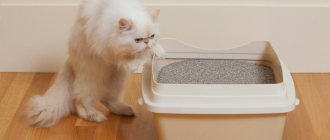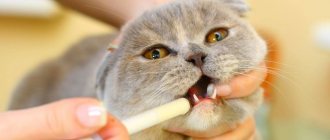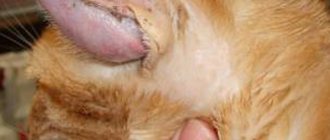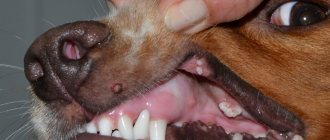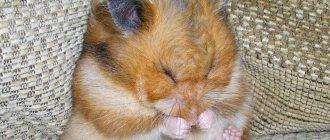Why do hamsters run away?
Most often, Djungarian hamsters disappear from their cages - they are very smart and inquisitive. Syrian hamsters run away less often. The reason could be a variety of factors:
- An unreliable cage - the pet will not be able to escape if the bars are not damaged and the lock works properly. But sometimes the animals gnaw through the bars and get out.
- Self-preservation instinct - if an animal feels danger, it tries to hide as far as possible.
- Fear – Your hamster may become frightened by loud noises.
- Curiosity – little furries strive to explore the world around them and are constantly looking for new places to explore.
- Fatigue - if the hamster has not had enough sleep or is tired, and you take him out of the cage to play, he will definitely run away at any opportunity.
- The carelessness of the owners is the most common reason. If you are distracted, the animal can take advantage of this and escape.
The pet can choose from the cage in different ways: get out through too large a gap between the bars, open a poorly secured door. In individual cages, the roof is secured with latches. If it is poorly secured, the animal can climb up the bars and crawl out through the crack. In a plastic cage, a rodent will simply gnaw at the wall and disappear unnoticed.
If the door is not closed properly, the animal may escape
Causes caused by incorrect temperature conditions
In order to understand whether the hamster is really sick if he does not move but breathes, it is worth performing a detailed examination
Attention should be drawn to the baby's eyes, breathing rate, and the naturalness of his posture. If your pet is breathing calmly and steadily with his eyes closed, it is most likely that he is just sleeping.
Heatstroke
It is known that individuals of the order of the hamster family, without exception, cannot tolerate heat or direct sunlight. Oddly enough, nature has deprived them of a system of protection against overheating; pets never sweat or breathe through their mouths like dogs. There are known cases where heat stroke resulted in death for animals.
To understand that your baby is overheated when he lies on his side and breathes heavily, you should pay attention to the presence of such signs as:
- no attempt to roll over or make any movements;
- lethargy;
- presence of seizures;
- impaired coordination of movements.
The likelihood of heatstroke occurring when your hamster is motionless and panting increases under the following conditions:
- improper transportation of the baby in personal transport;
- installing the cage on a balcony, window sill, in a place exposed to direct sunlight;
- installing the cage near heating devices;
- with high room humidity and stuffiness.
If you don’t immediately help your pet when he doesn’t move but is breathing, he may not be saved. For this reason, it is worth providing first aid to the animal, which is to:
- cool his body temperature - put the baby on a damp towel, tile, moisten his ears and paws with cool water. Do not rub frozen ice cubes or place them in water;
- inject subcutaneously 2 ml of water that the animal usually drinks to prevent dehydration;
- carry out anti-shock therapy - without waiting for the doctor, this should not be done. But if the ratologist is delayed, and the pet is getting worse, he can be given an injection in the hind leg (intramuscularly) of prednisolone 30 mg/ml with a syringe intended for administering insulin. The dose for a Syrian will be 0.1 ml, and for a Djungarian - 0.5 ml.
"Coma" or hibernation
If the hamster lies without moving, it is possible that the pet has fallen into a kind of coma, that is, into hibernation. His breathing remains calm and even, and his skin will be somewhat cool. In the wild, hibernation of individuals of the hamster order usually occurs in the winter season, when they need to survive cold, hunger, and decreased daylight hours.
The causes of “coma” can be the lack of food for several days in the absence of its strategic reserves, a heating shutdown or a sharp cold snap, which makes the apartment cool. The main signs that the baby is hibernating will be:
- closed eyes while breathing;
- cold but soft to the touch body;
- slow heartbeat (no more than a beat every 15 seconds).
In such cases, it is recommended to place the animal’s cage in a room where the temperature is equal to or above 20°C, and fill its feeder and drinking bowl. Within a few days, if all is well, the animal usually wakes up. If, after emerging from hibernation, he has impaired coordination of movement, which does not go away, he begins to sneeze, cough, or develops diarrhea, as evidenced by a wet tail, you should consult a veterinarian. And since it is undesirable to transport the baby after waking up from hibernation, it is better if he arrives on his own.
Common causes of falling on your back
However, not everything is so scary. When a hamster falls on its back, it may just be playing. The main reasons that can cause an animal to fall are:
And yet, if the hamster falls on its back, tumbles, runs on the drum, behaves actively, eats well, there is no need to worry, since everything is fine with it. In order to understand what provoked such animal behavior - a desire to have fun or illness, it is enough to observe for some time.
Due to excitement, it is difficult to figure out what to do if the hamster lies and does not move, but is breathing. After all, the presence of breathing means that the animal is still alive.
Before you run to the vet, you need to try to figure out why your pet is lying motionless
Pay attention to other signs: whether the eyes are closed, how often the rodent breathes. If the eyelids are closed and breathing is calm, the hamster may just
If a previously healthy animal suddenly falls into a coma, it is possible that it is hibernating. Breathing will be very rare, and the pet will be cold to the touch. In nature, dwarfs hibernate in winter, waiting out cold, hunger and short daylight hours.
Low room temperature
If the heating was turned off in the apartment, or you were going on vacation, this could provoke numbness. The body will be cold, the heartbeat will be extremely rare (1 beat every 15 seconds). A sleeping hamster can barely breathe; due to its small size, it is difficult to understand whether there is breathing at all. But if the body remains soft, the rodent has not died. To awaken the animal, the cage is placed in a warm room (more than 20 C), the feeder and drinking bowl are filled. The hamster should wake up in 2-3 days.
Heat
The Djungarian hamster lives in the steppes, and the Syrian even in semi-deserts, but both species are extremely sensitive to high temperatures and direct sunlight. Tiny nocturnal rodents with dense fur have no protection from overheating - they do not sweat or breathe through their mouths like dogs. Heat stroke is deadly for them.
Signs of hyperthermia:
- the hamster does not move and is breathing heavily;
- weakness;
- convulsions;
- impaired coordination of movements.
In case of acute overheating, heart failure leads to the death of the pet. Death may not occur immediately, but within a couple of days due to the failure of all organs, if the temperature has risen so much that proteins have coagulated in the blood and organs (at 44 C).
Situations in which there is a risk of heat stroke
- a cage on a windowsill or balcony, outside (sun);
- near heating devices;
- in a stuffy room with high humidity.
It can be difficult to understand why a hamster is lying on its side and breathing heavily if by the time the owner returns the sun has already gone and does not illuminate the cage.
Treatment for heat or sunstroke
Transporting a pet to a clinic in case of heat or sunstroke is not the best solution; time for first aid will be missed. What can you do without the help of a veterinarian to help your pet:
Reduce temperature
First aid is to cool the body, but not too sharply: applying ice or immersing the hamster in water is prohibited! The animal is placed on a tile or ceramic dish, or on a damp towel
Gently moisten ears and paws with cool water.
Fighting dehydration
Heatstroke very often occurs when there is no access to. When the animal is unconscious, it can no longer use the drinking bowl. However, it is also dangerous to drink a hamster from a syringe: it will not swallow, and the liquid will enter the lungs, making breathing difficult and causing pneumonia.
The liquid (sterile Ringer's solution or sodium chloride) is injected subcutaneously into 4-8 ml of Syrian and 2 ml of Djungarian hamsters.
Antishock therapy
Although all potent medications are best used as prescribed by a doctor, in a situation with acute overheating, the hamster may not survive to take the ratologist. If you feel like you have nothing to lose, you should inject prednisolone 30 mg/ml intramuscularly (in the hind leg) with an insulin syringe. The dose for a Dzhungarik is 0.05 ml, for a Syrian - 0.1 ml.
Whether your pet survives may depend on how long it was exposed to the high temperature. If the hamster does not die immediately, on the first day after overheating the owner often notices that the hamster falls over on its side and can barely walk. Neurological disorders are associated with swelling of the brain, and if the pet survives, coordination of movements will gradually be restored.
Solving the problem
Every furry owner needs to come to terms with the idea that it is almost impossible to wean an animal from doing this. You can only change the object of its action. Therefore, do not forget to feed not only vegetables and grass, but also tougher foods so that the hamster can wear down his teeth.
Indeed, due to the constant growth of teeth, they will become even more aggravated and injure the hamster’s mouth, and can even lead to his death. If such a situation arises, the veterinarian will be able to shorten the teeth, but this should be done only in extreme cases. Because stitching should be natural.
Another option that will wean the animal from gnawing the cage is to buy twigs, mineral stone, and vitamins for the hamster. Which will not only solve an unpleasant problem, but will also saturate the body with trace elements and beneficial substances. This will require little expense from you, but will bring maximum benefits.
Also, hamsters can chew on bars due to the large amount of energy, and then you just need to increase his load if it is low. This is easy to do: either buy him a large cage, or put a wheel or ball in which he can run.
Method No. 1
Don’t want your fluffy to bother you and decide on his own home? Then buy him something tasty and healthy. In stores you can now find a lot of treats for hamsters, which consist of different products, so you can choose the best option for you. It can be not only chips, but also sets of dried fruits, sprigs of his favorite fruit and much more. Although it is best to choose something harder so that the teeth grind down.
It is necessary to give such a treat to hamsters no more than once a day and most often before bedtime. So that the awake animal has something to do and does not disturb you. If you wish, you can make a similar product yourself using the same recipes as in store-bought treats.
Method No. 2
Don't forget about mineral stones for small rodents. After all, this is not only an effective method of weaning him from gnawing on his cage, but also a way to take care of the rodent’s health. This device looks like an ordinary stone with a high content of useful elements and vitamins for a hamster.
After all, they are very often not enough in the animal’s normal diet. Mineral stone can be purchased at any pet store and will last you a long time. Make sure to attach it to the cage or branches so that the hamster can always see it if he wants.
Method No. 3
In addition to treats for hamsters and stones, you can even make your own twigs for grinding down teeth. For this, you can use various trees, but the main thing is those that do not contain harmful resins that can be toxic to the hamster. If you take small branches, you will simply need to saw off the thorny elements and parts so that the animal does not harm itself. And also secure them in the cage. From time to time, the branches need to be replaced with new ones so that the baby always has something to do.
Method No. 4
You can do it differently and coat the bars of the cage with some unpleasant substance, but not a chemical solution, you don’t want the hamster to die. Use red pepper or lemon juice for this. So that after tasting the cage, the baby will understand that it is not tasty at all and is not worth his attention.
Method No. 5
You can wean your animal off a bad habit not only with stones or treats, but also with a special spray. Although it will only affect those animals that are more sensitive and capricious. But for the majority it will not have the desired effect. Therefore, the effectiveness here is purely individual.
Method number 6
Pay attention when the hamster sharpens its teeth on the cage and in what place. If he does this when he sees you with food or hears you open the refrigerator, then he may just want to eat.
And when he chews on the bars near the exit, he wants to walk free. And after that he won’t bother you anymore.
You need to be very attentive and take care of small rodents, because their desires are much more difficult to understand than a dog or a cat. Use all the tips and arrange a decent home for your hamster with mineral stones, vitamins, treats and twigs. And then you won’t have any problems with him.
How to stop a hamster from chewing its cage
The first step is to eliminate the reasons why the hamster began to chew the bars, so for this pet you need to do the following:
- Provide him with teeth sharpening toys. These could be apple tree branches, mineral stones or cardboard toilet paper tubes. If the rodent remains indifferent to them, then they can be rubbed with carrots or an apple. You should not offer your hamster branches or toys made of pine or cedar, as they are toxic to the small animal.
- Buy the animal a cage that is spacious enough and place in it a wheel, ladders, pipes and other devices for its activity. Their choice should be taken responsibly. You need to make sure that the wheel is the right size for the animal, otherwise it won’t mean anything to it.
- The animal should be provided with attention and play time outside the cage. Only during a walk you need to keep an eye on the hamster at all times so that it does not run away, and it is best to walk it in a fenced area or in a special walking ball.
- Do not disturb your hamster during the day when he is sleeping. It is better to choose the evening for games. In order not to disturb the rodent, during the day the cage can be covered with a blanket.
- You should show your hamster to a veterinarian, if his teeth have grown excessively, he will be able to carry out a procedure for shortening them.
If all of the above methods do not work, then the cage bars can be lubricated with a solution of citric acid or apple cider vinegar. Before this procedure, the hamster should be placed in another place and returned when everything is dry. You can also place the animal in a plexiglass dwelling such as an “aquarium”.
join the discussion
Share with your friends
If you decide to get a hamster, then it is possible that you will soon be faced with the fact that he will begin to chew on the cage. It’s worth taking a closer look at why a hamster chews its cage, how to wean it off it, and what recommendations from experts you should follow.
Features of handling Campbell's hamsters
Breeds of domestic hamsters are not as diverse as we used to think. Today it is common to breed the following breeds:
- Dzungarian (Sungur);
- Syrian hamsters;
- Angora hamster;
- Roborovsky's hamsters;
- Campbell's hamster.
Campbell's hamsters are one of the most problematic species to keep at home. For a comfortable stay for one hamster, it is enough to purchase a cage measuring 50 by 30 cm. Hamsters are unusually nimble, so the distance between the bars of the grid should not be more than 0.5 cm so that the pet does not escape. It is advisable to provide the animal with a running wheel. Under natural conditions, hamsters are excellent runners and sometimes cover considerable distances, so in a cage they need to receive sufficient physical activity.
Campbell's hamsters are nocturnal, which can be an obstacle to their communication with humans. They become active at night, and by morning they hide back in the house or nest. You can only communicate with them in the evening or early in the morning.
Incredible love of freedom is another characteristic feature of Campbell's hamsters. They don’t like to be picked up and begin to defend themselves and let their teeth in. Experienced owners often remove animals from cages while wearing gloves. However, once in your arms, these hamsters quickly come to their senses, becoming tame and affectionate.
Basic rules for caring for hamsters
Very often, animals that have experienced serious stress bother their owners with “bad” behavior.
Hamsters are nocturnal animals. Try to follow a routine and not wake up your pet during the day. Cages for Syrian hamsters should be properly equipped. These animals need toys, a running wheel and shelters. If the pet continues to chew on the cage despite its normal daily routine, nutrition and regular communication with the owner, it may simply be cramped. One animal needs at least 0.03 cubic meters of space. It is more interesting for rodents to live in multi-level cages where they can run around. If you think you're taking good care of your pet and don't understand why your hamster is chewing on its cage, consider whether you've been scaring it. These animals react negatively to loud sounds and tart aromas. It is advisable to place the cage with the pet in the quietest and most peaceful place in the apartment.
Possible problems
Ornamental animals at home are often deprived of the instincts and way of life that are inherent in their relatives in the wild. That is why this often leads to many problems, including those with the oral cavity.
That’s why, regardless of age and living conditions, your pet should be given attention every day
What to do if your teeth don't sharpen
A huge number of hamster owners face this problem. It often occurs as a result of an unbalanced diet or if the animal’s natural instincts at home are somewhat dulled. Often this phenomenon is accompanied by general lethargy of the rodent or other symptoms indicating systemic ailments. Therefore, it is recommended that your hamster be thoroughly examined by a veterinarian.
If the rodent is completely healthy and simply does not have time to wear down its teeth, they definitely need to be trimmed. To do this, you need to take nail scissors or nail clippers for cats. This must be done carefully, with smooth movements, up to a length of 5 mm. At the same time, it is also recommended to trim the claws on the paws so that the hamster does not injure himself and others. However, it is recommended to do all this at home only if you have the appropriate skills. In other cases, it is strongly recommended to consult a veterinarian.
Broken upper or lower tooth
Also, often during active games, an animal can break its front incisor. In this case, the lower or upper tooth can break on its own, due to an unbalanced diet or in adulthood. If you do not take decisive action, this can lead to serious problems in just 1-2 weeks.
First of all, the sharp edge can injure the oral cavity, which will cause many difficulties for proper nutrition. It should also be taken into account that the incisors do not grow synchronously, so over time the difference between the length of a healthy and broken incisor will be significant. To prevent all this from happening, the broken incisor must first be polished with a nail file. After this, the adjacent long tooth must be shortened to the length of the broken one.
Uneven growth of incisors
This problem can arise due to a number of factors, which also include genetic predisposition and the impact of closed living conditions. That is why it is not easy to accurately answer the question of why this happens. This pathology can take on a varied type of course, with each incisor growing either asynchronously or in pairs. In the latter case, there is a pathological enlargement of the two lower or two upper teeth, which can reach truly gigantic sizes.
What to do if your teeth are chattering
Sometimes a characteristic knocking sound may indicate problems with teeth. This occurs due to an incorrect taste caused by excessively long incisors. As a result, the pathological process leads to unpleasant or painful sensations that contribute to severe discomfort. This is especially evident with uneven growth of the incisors and subsequent distortion of taste.
However, a hamster can chatter its teeth even with a whole range of ailments, including cancer. That is why, when such a problem occurs, you need to contact a veterinarian as soon as possible. Often this will help prevent the development of serious consequences and death of the pet.
Causes
Hamsters do great in the wild because they don't have time to get bored. They search for food, dig holes, and hunt. Their life is quite interesting and active.
If the hamster lives at home, then, accordingly, he does not perform all the actions described above, since everything works out the same way.
Nature intends that a hamster's teeth grow throughout its life, so at home the pet can start gnawing on the bars of the cage. It is worth taking a closer look at the reasons why a hamster chews its cage.
- Grinding of teeth. Since the animal’s teeth are constantly growing, it grinds them down in this way. Usually this happens at night. Since he does not have branches of fruit trees or mineral stones nearby, he begins to chew everything that is nearby, including the bars of a metal cage, creating a lot of noise for those around him.
- Boredom . Since the rodent becomes protected from the usual actions carried out in the wild, it begins to get bored - for this reason, it gnaws at the cage.
- Hunger . Lack of food is also one of the reasons that the animal began to chew on the cage. You should not forget about your pet and monitor its diet.
- He sleeps little during the day . Since hamsters are nocturnal creatures, they sleep during the day. If you disturb a rodent during the day, you can expect it to behave inappropriately at night.
- Small cell. If the hamster is cramped, then he can show his protest by starting to gnaw on the bars. Thus, he wants to leave the uncomfortable housing.
What to do if your hamster is chewing on its cage
If hamsters under 6 months of age are chewing on the cage and it does not harm them, there is no need to worry. Kids are curious, they are interested in any detail that is inside the cage, including the cage itself. Over time, they will lose interest and stop chewing the bars.
If an adult hamster begins to chew on the cage, you should not disturb him. You need to give him the opportunity to gnaw on the bars, and at this time watch him. Note at what time he starts gnawing on the cage, in what place, whether he has food in the feeder and the presence of solid food.
If you often let the rodent out of the cage to run around the apartment or the play area is located outside the cage, this way it can attract attention so that it can be let out for a walk. If, after observing the hamster, it is impossible to determine the reason for this behavior, you can try the following methods:
If, after observing the hamster, it is impossible to determine the reason for this behavior, you can try the following methods:
Switch the hamster's interest to another item:
Tree branches. Offer the hamster branches of apple, pear, and birch trees. Before feeding the hamster the branches, they must be pre-treated. Clean the bark of dirt and moss, then rinse under hot water to kill all microorganisms. Then the branches need to be scalded with boiling water, cooled and fed to the hamster. You can also purchase ready-made hazel sticks at the pet store.
Solid treat. At the pet store you can find a wide range of treats for rodents. The most common are cereal sticks with honey, which hamsters really like. You can also purchase tartlets with vegetables, grains or nuts.
Mineral stone. The stone is very useful not only for the hamster’s teeth, but also for the body. Contains a large amount of vitamins, minerals and trace elements that a hamster needs to maintain an active lifestyle. The stone needs to be attached to the bars of the cage so that it is convenient for the hamster to chew on it.
Fruits vegetables
It is very important to feed hamsters not only with soft, succulent food, but also with solid vegetables and fruits every day. Hamsters especially love to chew carrots, sweet bell peppers or apples.
Diversify your hamster's leisure time.
You need to install a running wheel, labyrinths, and tunnels in the cage. To prevent the hamster from gnawing at the cage out of boredom at night, it is necessary to maintain its physical activity. Toys for a hamster must be chosen according to its size. If you buy a small running wheel and your hamster is large, he will not be comfortable and will lose interest in it. Playground. Special playgrounds are sold for hamsters, which are installed outside the cage. Playgrounds come in open and closed types. The hamster must be moved from the cage to the area
It is important not to forget and return the hamster back to the resting cage. Ball. Great for keeping your hamster active
The ball can be safely used to move freely around the room.
How to stop a hamster from chewing its cage
If the proposed methods only temporarily distract the hamster, and he continues to chew on the cage, you can try to wean the rodent from this habit.
Aloe or lemon juice. You need to smear the cage bars with aloe or lemon juice. Aloe juice tastes bitter, and lemon is too sour for a rodent
The hamster will try to chew the cage, but the unpleasant taste will discourage him, and he will switch his attention to other entertainment. To stop your hamster from chewing on rods, you should never use chemicals.
They can be harmful to your pet's health. Spray "Anti-gryzin". The spray costs about 200 rubles. It is quite difficult to purchase such a product in a pet store, since it is not in great demand. Home remedies are more often used, they are more natural.
How to stop a hamster from chewing its cage?
In fact, ways to counteract such behavior are quite easy to select based on the reasons themselves.
- Remember to give your pet solid food along with regular grains and cereals so that the teeth grinding needs are met naturally. Additionally, you can place small twigs or special mineral stones in the cage, sold in pet stores. They will also be a very interesting and useful activity that distracts the animal from a bad habit.
- Try to periodically, preferably even daily, walk your hamster in the apartment. This will give him the opportunity to run around and use up the accumulated energy. There are several options for the “walk”. You can monitor the pet yourself, limiting its movements, or organize a small “pen” in a safe area (where it cannot find a cozy hole). Usually, over time, animals get used to walking and, tired, they themselves tend to return to the cage, if they have access to it, since this is where their home is located with a nest for sleeping and food supplies. If for some reason it is impossible to organize a walk in this way, you can try giving the rodent a special ball for walking. It will provide freedom of movement and prevent the animal from going where it shouldn’t.
- Try to arrange the cage so that there is always something to do in it. Place ladders, small closed houses and a standard spinning wheel inside.
- If all of the above measures do not have an effect, there is only one option left - to use a repellent. It is usually created on the basis of natural ingredients that have an unpleasant smell and taste for rodents. To do this, you need to remove the animal, treat the rods, wait for them to dry, and only then return the resident to his place. Having taken up the usual task, the rodent will be very surprised by the bitterness and unpleasant taste of the twigs, after which the desire to gnaw on them should completely disappear.
Proper nutrition
There is a wide variety of food for rodents on display at pet stores. However, despite what the labels say, not all of them are created equal. Cheap food is not suitable for feeding hamsters - they are usually of poor quality, incorrectly balanced, and do not contain all the necessary substances and vitamins. There have been cases where rodent poison was found in food, which caused the death of pets.
For normal functioning, hamsters need balanced dry food. It should include cereals, plant seeds, herbs and flowers, as well as protein supplements in the form of dried insects.
It is important to give hamsters allowed vegetables and fruits. You can feed hamsters cucumber, zucchini, broccoli, cauliflower, lettuce, turnips, radish
Types of hamsters that are not predisposed to diabetes can be given pumpkin, carrots, fruits and dried fruits.
It is forbidden to give onions, white cabbage, sorrel.
Number of teeth
Surely, you will be interested to know how many teeth a hamster has - Djungarian, Syrian and others. It is very difficult to count them yourself, since the rodent, like other animals, does not like it when people look into its mouth. Most people think that a fluffy's mouth consists of a pair of large teeth on the upper and lower jaws.
In fact, the animal has 16 teeth in the oral cavity - the same 4 incisors in front and another 6 lateral molars, which do not stand out at a superficial glance at the animal’s mouth. Their role in the body is very important - with the help of the incisors, the pet grinds, and with the lateral molars, chews all the food before it enters the gastrointestinal tract. To examine, pull the animal by the mane and slightly move the cheek pouches.
Inexperienced owners may be concerned about why their hamster has yellow teeth. Don’t worry, this enamel color is normal for them, and not a sign of any pathology or a consequence of poor nutrition.
The shade of the enamel may change to a darker color when the animal consumes food with a high content of dyes. Give preference to cereals, fresh fruits and vegetables. It is also possible that the darkening is age-related: your pet is simply getting old.
Possible consequences of this behavior
The metal bars of your home are not a suitable material for grinding down teeth. Thus, the animal can break them and injure the oral cavity. In this case, you will have to show your pet to the veterinarian. In addition, such a grinding noise will constantly disturb the animal’s owners from sleeping at night.
Important! It should be noted that the metal bars of such a dwelling are often coated with paint, which, if it gets into the intestines of a rodent, can cause problems with its health.
Useful tips
To make the search for the fugitive successful, follow simple rules:
- If there are other pets living in the apartment, move them away from the place where the hamster is supposed to be.
- When using mousetraps, be sure to remove them so that the animal does not get caught in them.
- Once you find an animal, limit its movement around the apartment. To do this, close all exits from the room.
- To avoid scaring the tiny creature, do not make loud or harsh sounds.
- Quite rarely, a hamster can be found in the folds of clothes, towels or bed linen - he climbs there to keep warm.
Check the cage regularly to eliminate defects in a timely manner, and ensure that the door is closed tightly. Make sure your pet is comfortable in his house and there are no irritating factors nearby. Give the animal more time and buy toys if necessary. The best way to catch a hamster is to prevent it from escaping.
What does it mean if a rodent has stopped damaging the house?
If you find that the hamster no longer chews twigs, then the measures taken have worked. The animal is happy: it sleeps enough, enjoys suitable food, does not experience boredom and frolics with numerous toys.
It is worth noting that if the furry hooligan has not stopped committing his insidious atrocities, then this activity brings him pleasure . You need to come to terms with your pet’s eccentric nature and move the cage away from the bed at night to protect your sleep.
Gastrointestinal diseases
There are various diseases of hamsters that are caused by pathogenic microorganisms. Among them, veterinarians identify pathologies of the digestive tract. They cause gastrointestinal disorders, and in severe cases can lead to the death of the animal.
Worms are also common in hamsters, which enter the body along with contaminated food or water. The disease can be determined by the slow growth of young animals, sudden weight loss (with normal nutrition), problems with fur (for example, oily sheen)
It is also worth paying attention to the consistency of the stool: it becomes soft, the mass contains blood, mucus or fragments of parasites
Colibacillosis
This disease in hamsters is caused by E. coli. Colibacillosis is also called “wet tail”. This is because loose stools cause the fur around the hamster's anus to be wet.
The disease occurs as a result of the penetration of E. coli into the body. The source of infection is contaminated food or water.
You can tell that your hamster has colibacillosis by the following symptoms:
- watery diarrhea with a pungent odor;
- decrease or disappearance of appetite;
- weight loss;
- anxiety;
- depression, lethargy, apathetic state;
- exhaustion of the body;
- sometimes high temperature;
- uncertain movements;
- increased heart rate and breathing.
Specific signs of colibacellosis are loose stools and wet fur around the anus. The hamster is constantly trying to find a secluded place and curl up into a ball. He looks sloppy, his fur is disheveled, his ears are flattened, he doesn't move much.
The disease develops quickly, so treatment must be started in the early stages. Therapy is carried out under the supervision of the attending physician. The infection should be treated with electrolyte solutions and antibiotics (tetracyclines are often used). The former improve the hydration process, while the latter destroy bacteria in the intestines.
Therapy is carried out at home. During the treatment period, you must follow the diet prescribed by the ratologist.
Escherichia coli
Hamster diseases caused by E. coli can lead to the death of the pet. The infection begins to develop after a pathogenic microorganism enters the animal’s body, which begins to multiply rapidly. Because of this, the natural intestinal microflora changes, and the hamster’s condition deteriorates sharply.
Signs of an illness caused by E. coli:
- high body temperature;
- diarrhea with blood streaks;
- weakness, apathy;
- the animal does not eat anything;
- weight loss;
- blanching of the mucous membranes.
The infection progresses quickly and often ends in the death of the animal. To prevent this from happening, when the first symptoms of the disease appear, you need to contact a ratologist. The doctor will prescribe a bacteriological analysis to identify the pathogen and develop treatment tactics. Intestinal antiseptics and antibiotics will help destroy the source of infection.
You can get E. coli from a sick hamster. To avoid this, a person should thoroughly wash their hands with soap after contact with the animal. To prevent illness, you should keep your home clean.
Enteritis
This is a disease in which the inflammatory process affects the small intestine (some parts or all of it). As a result, its functionality is impaired, and dystrophic changes appear on the mucous membrane. Then various digestive disorders arise.
The main reason for the development of enteritis in a hamster is considered to be the lack of hay in its diet. The disease is manifested by increased gas formation in the intestines and diarrhea.
Enteritis is treated by introducing high quality hay into the hamster's diet. Specific therapy is also carried out: the feces of a healthy animal are diluted with water, and then administered through an enema into the patient’s intestines.
How to set up a cage for a Djungarian hamster
The spacious cage can accommodate additional attributes. Some of them are mandatory, others are installed at the request of the owners.
Similar products are available in any pet store, some of them are easy to make with your own hands.
An important attribute for the comfortable existence of Djungarian hamsters is bedding. This is the substrate with which the bottom is covered. You cannot take cotton wool, bandages and other materials consisting of threads for these purposes (so that the animals do not get entangled in them).
Sawdust from pine and cedar is also prohibited, as they are sources of the development of respiratory diseases in rodents.
The traditional option is sawdust from deciduous trees. Layer - at least 6 cm. An alternative is to buy ready-made litter. These are special fillers, silica gels, granular mixtures.
Other necessary “interior” elements for dzhungariks
A house is a secluded place in which the animal will store its supplies and sleep. Mandatory elements are a wide entrance and a strong roof.
Feeder - small size, spacious, sides 1-1.5 cm.
Drinking bowl - it is better to buy special products, since the hamster will turn over ordinary bowls/lids. The optimal solution is a nipple drinker attached to the outside of the cage.
A running wheel is a necessary element for the dwarf to get daily exercise, stretch his paws and train his cardiovascular system.
Requirements:
- diameter – not less than 20 cm;
- non-slippery surface;
- fastening to rods.
- Wheels with crossbars and mesh are prohibited.
Mineral salt stone - needed for natural needs (grinding teeth), it will also enrich the animal’s body with useful microelements.
How to avoid fights between pets?
Many people wonder what to do when hamsters fight. First of all, you should take care of stopping the bloodbath. Since pets from the hamster order have rather sharp incisors, they can seriously injure a person if he tries to separate the fighters with his bare hands. It is best to disperse the hamsters to different corners using improvised means and immediately get one of them.
The only way out of this situation, which explains what to do, is to resettle the hamsters. You shouldn’t let the situation lead to real bloody slaughter, because in the daytime, when individuals are least active, you may not notice that they have certain disagreements in dividing the territory. These animals are nocturnal predators, and therefore, most likely, only in the morning the owners will be able to see traces of the struggle between them.
When moving dwarf hamsters into one home, it is worth remembering that it should be as spacious as possible. In addition, there should be enough attractions such as running wheels, houses with several floors, allowing children to move freely in them. Otherwise, disagreements that cannot be resolved peacefully will arise between individuals of this breed.
Possible reasons
In their natural environment, hamsters lead a fairly active lifestyle: they dig holes and underground passages, look for food, and hunt. When keeping such a cute animal at home, the pace of life is not so fast. The desire to chew is his instinctive need. There may not be one answer as to why he is doing this. When a hamster chews its cage, it happens for a number of reasons.
Grinding down teeth
It is so inherent in nature that rodents’ teeth grow all the time, and they should be ground down. In nature, a hamster can sharpen them on wood, branches and other objects. Otherwise, they may grow to an uncomfortable size.
At home, the animal begins to be attracted to the cage. Moreover, he may also start gnawing on everything that comes to hand - a house, toys, a feeding trough. In this case, you need to make sure that there are always mineral stones or branches of fruit trees and shrubs in the animal’s home. The rodent will grind its teeth on them with great pleasure. If they are not available, he will switch to the bars of the cage. Periodically, gnawed branches need to be replaced with new ones.
Boredom
Another reason for this behavior is boredom from having nothing to do. He needs to direct his activity towards something, and this is expressed in the fact that he chews on the cage. In this case, the animal should be distracted. It is recommended to equip the home with a wheel, ladders, bridges, passages, a house with several floors and various toys. This will allow the animal to be active even in a confined space.
You should not let your hamster roam around the apartment on its own. You may simply not find him, and he can chew on many objects, so for such walks it is better to use a walking ball.
Hunger
This behavior may also mean that the hamster is hungry and wants to eat. It is necessary to ensure that there is always food in the feeder and drink in the drinking bowl. Be sure to also include solid food in your diet to wear down your teeth. Stale food should be removed from the cage.
Didn't sleep much during the day
In hamsters, activity occurs at night. If the animal is not allowed to sleep during the day, then at night it will behave irritably, so it is better to clean the home and communicate with the pet in the evening. The home itself should be located in a quiet, peaceful place, away from sunlight. Another reason you should not try to play or train your hamster during the day is that it will irritate the rodent and it may bite you.
small cage
A small dwelling does not allow this small animal to show its activity as it should. A small cage depresses him. He informs the owner about this by gnawing its rods with his teeth. To solve this problem, it is enough to purchase a cage of suitable size.
Why does a hamster chew on its cage?
First of all, this happens because he is a rodent. You can’t fool nature, hamsters’ teeth grow quickly, they need to be ground down using improvised means. Iron rods are ideal for sharpening your teeth. For a rodent this is a natural process.
The second, less common reason why hamsters chew on their cage: boredom, dissatisfaction with living conditions. The hamster really loves drums and wheels that can be spun, if they are not included with the animal’s housing, be sure to pamper your baby with such things. Once he masters them, he will sharpen his teeth on the bars much less often. Lack of physical activity often provokes the development of a bad habit; provide your pet with the opportunity to live life to the fullest and move as much as he wants.
If you have done everything possible, but your pet constantly chews on the bars, it means that he likes this activity or does not like living in a cramped cage
Therefore, even before purchasing an animal, it is important to choose the right cage and equip it. Hamster owners recommend putting a birch twig on the hamster - the baby will like the slight smell of wood



